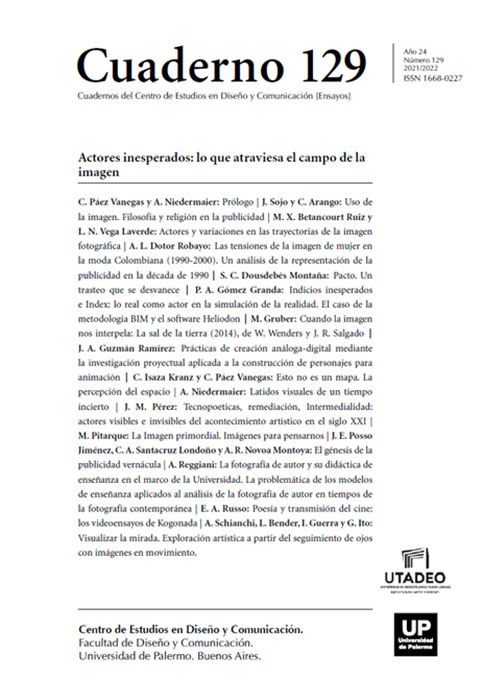Indicios inesperados e Index: lo real como actor en la simulación de la realidad. El caso de la metodología BIM y el software Heliodon
Abstract
This article explores the relationship between the categories of reality and real, in the digital image framework, specifically in the simulations through the Heliodon software and the conception/construction processes associated with the BIM methodology. The problem of the unexpected actor as an artifact of visual culture arises from this relationship. The fictitious, subjective image corresponds to reality, organized in indexes, and ready to be archived. On the contrary, to the real corresponds the image of the indications, objective, of the potency, the image of the artifact inadequate to the current indexing processes. The hypothesis is that, given the characteristics of the BIM methodology and the simulations of the Heliodon software, it is possible to give space to the unexpected in the field of the image; this is, to the indications of the real in the image of reality. The base on which we build the topic unfolds in four acts: a problematization of the real and its possibilities of action as excluded from reality and its images; a description of how an unexpected actor, the making at the Bauhaus, breaks into an index of conception/realization; an epistemological differentiation between index and traces notions; an argumentation of the possibilities of action that the real presents within the BIM methodology and the Heliodon software.
References
Alembert J. Le R. (2011). Discours préliminaire de l’Enciclopedie, Édition électronique (ePub, PDF), Cégep de Trois-Rivières (Canadá): Les Échos du Maquis.
Agamben, G. (2017). Karman. Court traité sur l’action, la faute et le geste. Traducido del italiano por Joël Gayraud. París: Ëditions du Seuil.
Baudelaire, Ch. (2010 ). Le peintre de la vie moderne. París: 1001 nuits.
Baxandall, M. D. K. (1988). Painting and experience in fifteenth century Italy: a primer in the social history of pictoral style, New York: Oxford University Press.
Benjamin, W. (1982). Charles Baudelaire: un poète lyrique à l’apogée du capitalisme. Traducción del alemán por Jean Lacoste. París: Payot.
Deleuze, G. (1969). Logique du sens. París: Éd. De Minuit.
Deleuze, G. (2013). Spinoza: Filosofía practica. Traducido del francés por Antonio Escohotado. Buenos Aries: Tusquets.
Deleuze, G. y Guattari, F. (1993). ¿Qué es la filosofía? Traducido del francés por Thomas Kauf. Barcelona: Anagrama.
Huyghe, P-D. (2017). Contre-Temps. De la recherche et de ses enjeux: art, architecture, design. París: B42.
Huyghe, P-D. (2015). Art et Industrie: Philosophie du Bauhaus. París: Circé.
Huyghe, P-D. (2009). Modernes sans modernités. Éloge ds mondes sans style. París: Éditions Lignes.
Moholy-Nagy, L. (2007). Peinture, Photographie, Film et autres écrits sur la photographie. Traducción del ingles y del alemán por Gérard Dallez, Jean Kempf y Catherine Wermester. París: Gllimard, Folio.
Nuño, J. (2007). El pensamiento de Platón. Madrid: Éd. Fondo de Cultura Económica.
Van Lier, H. (2005). Philosophie de la Phtotographie. París: Les impressions nouvelles.
Van Lier, H. De la méthapysique à l’anthropogénie, disponible en http://www.anthropogenie.com/anthropogenie_locale/ontologie/metaphysique.htm. Consultado el 29, mayo, 2020.
Wright, F. L. (2003). L’avenir de l’architecture. Traducción del ingles por Mathilde Bellaigue y Georges Loudière. París: Éditions du Linteau.
Platón .(1987). Parménides. Traducido del griego por Guillermo R. de Echandía. Madrid: Ediciones Alianza.
Sullivan, L. H. (1896). “The tall office building artistically considered”, en Lippincott’s Magazine, March 1896
Los autores/as que publiquen en esta revista ceden los derechos de autor y de publicación a "Cuadernos del Centro de Estudios de Diseño y Comunicación", Aceptando el registro de su trabajo bajo una licencia de atribución de Creative Commons, que permite a terceros utilizar lo publicado siempre que de el crédito pertinente a los autores y a esta revista.


